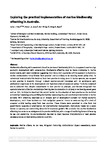Exploring the practical implementation of marine biodiversity offsetting in Australia
| dc.contributor.author | Niner, Holly | |
| dc.contributor.author | Jones, PJS | |
| dc.contributor.author | Milligan, B | |
| dc.contributor.author | Styan, C | |
| dc.date.accessioned | 2022-05-04T08:22:58Z | |
| dc.date.issued | 2021-10 | |
| dc.identifier.issn | 0301-4797 | |
| dc.identifier.issn | 1095-8630 | |
| dc.identifier.other | 113062 | |
| dc.identifier.uri | http://hdl.handle.net/10026.1/19173 | |
| dc.description.abstract |
Biodiversity offsetting with associated aims of no net loss of biodiversity (NNL) is an approach used to align economic development with conservation. Biodiversity offsetting may be more challenging in marine environments, with recent evidence suggesting that the current application of the approach in Australian marine environments rarely follows 'best practice' and is unlikely to be meeting stated policy aims. To understand how and why this deviation from best practice is taking place in marine systems, we analysed current practice in Australia through in-depth semi-structured interviews with 31 participants with professional experience in the development and implementation of associated policy. Thematic analysis of results indicated that, despite commitment to best practice in principle, practitioners recognised that operationalisation of marine biodiversity offsetting was inconsistent and unlikely to be meeting stated goals such as NNL. Participants described the central barrier to the adoption of best practice as the technical complexity of assessing and quantifying biodiversity losses and gains, and uncertainty in restoration in marine contexts. With offsetting described as an integral part of development consent for marine economic development, both these barriers and their navigation presents threats to users setting off a chain of accepted activity leading away from best practice. These threats were perceived to arise from low governmental capacity or prioritisation for environmental management, institutional needs for a social licence to operate, and overarching demands for economic growth. We conclude that marine biodiversity offsetting has come to be ambiguous in its practical definition, with a range of conflicting factors influencing its use and preventing the standardisation required to meet rigorous interpretations of best practice necessary to ensure biodiversity protection and NNL. | |
| dc.format.extent | 113062-113062 | |
| dc.format.medium | Print-Electronic | |
| dc.language | en | |
| dc.language.iso | eng | |
| dc.publisher | Elsevier BV | |
| dc.subject | Marine offsets | |
| dc.subject | No net loss | |
| dc.subject | Mitigation hierarchy | |
| dc.subject | Environmental impact assessment | |
| dc.subject | Social licence to operate | |
| dc.title | Exploring the practical implementation of marine biodiversity offsetting in Australia | |
| dc.type | journal-article | |
| dc.type | Journal Article | |
| plymouth.author-url | https://www.webofscience.com/api/gateway?GWVersion=2&SrcApp=PARTNER_APP&SrcAuth=LinksAMR&KeyUT=WOS:000681298500002&DestLinkType=FullRecord&DestApp=ALL_WOS&UsrCustomerID=11bb513d99f797142bcfeffcc58ea008 | |
| plymouth.volume | 295 | |
| plymouth.publication-status | Published | |
| plymouth.journal | Journal of Environmental Management | |
| dc.identifier.doi | 10.1016/j.jenvman.2021.113062 | |
| plymouth.organisational-group | /Plymouth | |
| plymouth.organisational-group | /Plymouth/Faculty of Science and Engineering | |
| plymouth.organisational-group | /Plymouth/Faculty of Science and Engineering/School of Biological and Marine Sciences | |
| plymouth.organisational-group | /Plymouth/Users by role | |
| plymouth.organisational-group | /Plymouth/Users by role/Academics | |
| dc.publisher.place | England | |
| dcterms.dateAccepted | 2021-06-08 | |
| dc.rights.embargodate | 2022-6-20 | |
| dc.identifier.eissn | 1095-8630 | |
| rioxxterms.versionofrecord | 10.1016/j.jenvman.2021.113062 | |
| rioxxterms.licenseref.uri | http://www.rioxx.net/licenses/all-rights-reserved | |
| rioxxterms.licenseref.startdate | 2021-10-01 | |
| rioxxterms.type | Journal Article/Review |


